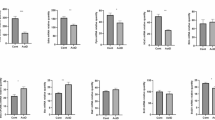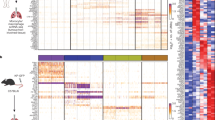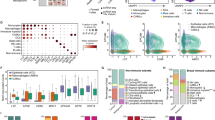Abstract
Many cells die during mammalian development and are engulfed by macrophages. In DNase II−/− embryos, the TUNEL-positive DNA of apoptotic cells is left undigested in macrophages, providing a system for studying programmed cell death during mouse development. Here, we showed that an Apaf-1-null mutation in the DNase II−/− embryos greatly reduced the number of macrophages carrying DNA at E11.5. However, at later stages of the embryogenesis, a significant number of macrophages carrying undigested DNA were present in Apaf-1−/− embryos, indicating that cells died and were engulfed in an Apaf-1-independent manner. In most tissues of the Apaf-1−/− embryos, no processed caspase-3 was detected, and the DNA of dead cells accumulated in the macrophages appeared intact. Many nonapoptotic dead cells were found in the tail of the Apaf-1−/− embryos, suggesting that the Apaf-1-independent programmed cell death occurred, and these dead cells were engulfed by macrophages. In contrast, active caspase-3 was detected in E14.5 thymus of Apaf-1−/− embryos. Treatment of fetal thymocytes with staurosporine, but not etoposide, induced processing of procaspases 3 and 9, indicating that the E14.5 thymocytes have the ability to undergo caspase-dependent apoptosis in an Apaf-1-independent manner. Thus, programmed cell death in mouse development, which normally proceeds in an efficient Apaf-1-depenent mechanism, appears to be backed up by Apaf-1-independent death systems.
Similar content being viewed by others
Log in or create a free account to read this content
Gain free access to this article, as well as selected content from this journal and more on nature.com
or
Abbreviations
- CAD:
-
caspase-activated DNase
- mAb:
-
monoclonal antibody
References
Jacobson MD, Weil M, Raff MC . Programmed cell death in animal development. Cell 1997; 88: 347–354.
Vaux DL, Korsmeyer SJ . Cell death in development. Cell 1999; 96: 245–254.
Kerr JF, Wyllie AH, Currie AR . Apoptosis: a basic biological phenomenon with wide-ranging implications in tissue kinetics. Br J Cancer 1972; 26: 239–257.
Adams JM . Ways of dying: multiple pathways to apoptosis. Genes Dev 2003; 17: 2481–2495.
Danial NN, Korsmeyer SJ . Cell death: critical control points. Cell 2004; 116: 205–219.
Nagata S . Apoptosis by death factor. Cell 1997; 88: 355–365.
Strasser A, Jost PJ, Nagata S . The many roles of FAS receptor signaling in the immune system. Immunity 2009; 30: 180–192.
Nagata S . DNA degradation in development and programmed cell death. Annu Rev Immunol 2005; 23: 853–875.
Jiang X, Wang X . Cytochrome c-mediated apoptosis. Annu Rev Biochem 2004; 73: 87–106.
Schafer ZT, Kornbluth S . The apoptosome: physiological, developmental, and pathological modes of regulation. Dev Cell 2006; 10: 549–561.
Fadok VA, Bratton DL, Frasch SC, Warner ML, Henson PM . The role of phosphatidylserine in recognition of apoptotic cells by phagocytes. Cell Death Differ 1998; 5: 551–562.
Ravichandran KS, Lorenz U . Engulfment of apoptotic cells: signals for a good meal. Nat Rev Immunol 2007; 7: 964–974.
Kuida K, Haydar TF, Kuan CY, Gu Y, Taya C, Karasuyama H et al. Reduced apoptosis and cytochrome c-mediated caspase activation in mice lacking caspase 9. Cell 1998; 94: 325–337.
Yoshida H, Kong YY, Yoshida R, Elia AJ, Hakem A, Hakem R et al. Apaf1 is required for mitochondrial pathways of apoptosis and brain development. Cell 1998; 94: 739–750.
Hao Z, Duncan GS, Chang CC, Elia A, Fang M, Wakeham A et al. Specific ablation of the apoptotic functions of cytochrome c reveals a differential requirement for cytochrome c and Apaf-1 in apoptosis. Cell 2005; 121: 579–591.
Cecconi F, Alvarez-Bolado G, Meyer BI, Roth KA, Gruss P . Apaf1 (CED-4 homolog) regulates programmed cell death in mammalian development. Cell 1998; 94: 727–737.
Lindsten T, Ross AJ, King A, Zong WX, Rathmell JC, Shiels HA et al. The combined functions of proapoptotic Bcl-2 family members bak and bax are essential for normal development of multiple tissues. Mol Cell 2000; 6: 1389–1399.
Marsden VS, O’Connor L, O’Reilly LA, Silke J, Metcalf D, Ekert PG et al. Apoptosis initiated by Bcl-2-regulated caspase activation independently of the cytochrome c/Apaf-1/caspase-9 apoptosome. Nature 2002; 419: 634–637.
Okamoto H, Shiraishi H, Yoshida H . Histological analyses of normally grown, fertile Apaf1-deficient mice. Cell Death Differ 2006; 13: 668–671.
Kawane K, Fukuyama H, Kondoh G, Takeda J, Ohsawa Y, Uchiyama Y et al. Requirement of DNase II for definitive erythropoiesis in the mouse fetal liver. Science 2001; 292: 1546–1549.
Kawane K, Fukuyama H, Yoshida H, Nagase H, Ohsawa Y, Uchiyama Y et al. Impaired thymic development in mouse embryos deficient in apoptotic DNA degradation. Nat Immunol 2003; 4: 138–144.
Krieser RJ, MacLea KS, Longnecker DS, Fields JL, Fiering S, Eastman A . Deoxyribonuclease IIalpha is required during the phagocytic phase of apoptosis and its loss causes lethality. Cell Death Differ 2002; 9: 956–962.
Wu YC, Stanfield GM, Horvitz HR . NUC-1, a Caenorhabditis elegans DNase II homolog, functions in an intermediate step of DNA degradation during apoptosis. Genes Dev 2000; 14: 536–548.
Mukae N, Yokoyama H, Yokokura T, Sakoyama Y, Nagata S . Activation of the innate immunity in Drosophila by endogenous chromosomal DNA that escaped apoptotic degradation. Genes Dev 2002; 16: 2662–2671.
Reddien PW, Horvitz HR . The engulfment process of programmed cell death in Caenorhabditis elegans. Annu Rev Cell Dev Biol 2004; 20: 193–221.
Yoshida H, Okabe Y, Kawane K, Fukuyama H, Nagata S . Lethal anemia caused by interferon-beta produced in mouse embryos carrying undigested DNA. Nat Immunol 2005; 6: 49–56.
Denecker G, Vercammen D, Steemans M, Vanden Berghe T, Brouckaert G, Van Loo G et al. Death receptor-induced apoptotic and necrotic cell death: differential role of caspases and mitochondria. Cell Death Differ 2001; 8: 829–840.
Surh CD, Sprent J . T-cell apoptosis detected in situ during positive and negative selection in the thymus. Nature 1994; 372: 100–103.
Verney C, Takahashi T, Bhide PG, Nowakowski RS, Caviness Jr VS . Independent controls for neocortical neuron production and histogenetic cell death. Dev Neurosci 2000; 22: 125–138.
Thomaidou D, Mione MC, Cavanagh JF, Parnavelas JG . Apoptosis and its relation to the cell cycle in the developing cerebral cortex. J Neurosci 1997; 17: 1075–1085.
Blaschke AJ, Staley K, Chun J . Widespread programmed cell death in proliferative and postmitotic regions of the fetal cerebral cortex. Development 1996; 122: 1165–1174.
Rodewald HR, Moingeon P, Lucich JL, Dosiou C, Lopez P, Reinherz EL . A population of early fetal thymocytes expressing Fc gamma RII/III contains precursors of T lymphocytes and natural killer cells. Cell 1992; 69: 139–150.
Kaufmann SH . Cell death induced by topoisomerase-targeted drugs: more questions than answers. Biochim Biophys Acta 1998; 1400: 195–211.
Maeno E, Ishizaki Y, Kanaseki T, Hazama A, Okada Y . Normotonic cell shrinkage because of disordered volume regulation is an early prerequisite to apoptosis. Proc Natl Acad Sci USA 2000; 97: 9487–9492.
Hara H, Takeda A, Takeuchi M, Wakeham AC, Itie A, Sasaki M et al. The apoptotic protease-activating factor 1-mediated pathway of apoptosis is dispensable for negative selection of thymocytes. J Immunol 2002; 168: 2288–2295.
Matsuki Y, Zhang HG, Hsu HC, Yang PA, Zhou T, Dodd CH et al. Different role of Apaf-1 in positive selection, negative selection and death by neglect in foetal thymic organ culture. Scand J Immunol 2002; 56: 174–184.
Ekert PG, Read SH, Silke J, Marsden VS, Kaufmann H, Hawkins CJ et al. Apaf-1 and caspase-9 accelerate apoptosis, but do not determine whether factor-deprived or drug-treated cells die. J Cell Biol 2004; 165: 835–842.
Kroemer G, Galluzzi L, Vandenabeele P, Abrams J, Alnemri ES, Baehrecke EH et al. Classification of cell death: recommendations of the Nomenclature Committee on Cell Death 2009. Cell Death Differ 2009; 16: 3–11.
Chautan M, Chazal G, Cecconi F, Gruss P, Golstein P . Interdigital cell death can occur through a necrotic and caspase-independent pathway. Curr Biol 1999; 9: 967–970.
Wei MC, Zong WX, Cheng EH, Lindsten T, Panoutsakopoulou V, Ross AJ et al. Proapoptotic BAX and BAK: a requisite gateway to mitochondrial dysfunction and death. Science 2001; 292: 727–730.
Chung S, Gumienny TL, Hengartner MO, Driscoll M . A common set of engulfment genes mediates removal of both apoptotic and necrotic cell corpses in C. elegans. Nat Cell Biol 2000; 2: 931–937.
Krysko DV, Denecker G, Festjens N, Gabriels S, Parthoens E, D’Herde K et al. Macrophages use different internalization mechanisms to clear apoptotic and necrotic cells. Cell Death Differ 2006; 13: 2011–2022.
Zwart B, Ciurana C, Rensink I, Manoe R, Hack CE, Aarden LA . Complement activation by apoptotic cells occurs predominantly via IgM and is limited to late apoptotic (secondary necrotic) cells. Autoimmunity 2004; 37: 95–102.
Hanayama R, Tanaka M, Miyasaka K, Aozasa K, Koike M, Uchiyama Y et al. Autoimmune disease and impaired uptake of apoptotic cells in MFG-E8-deficient mice. Science 2004; 304: 1147–1150.
Botto M, Dell’Agnola C, Bygrave AE, Thompson EM, Cook HT, Petry F et al. Homozygous C1q deficiency causes glomerulonephritis associated with multiple apoptotic bodies. Nat Genet 1998; 19: 56–59.
Fadok VA, Bratton DL, Guthrie L, Henson PM . Differential effects of apoptotic versus lysed cells on macrophage production of cytokines: role of proteases. J Immunol 2001; 166: 6847–6854.
Muller U, Steinhoff U, Reis LF, Hemmi S, Pavlovic J, Zinkernagel RM et al. Functional role of type I and type II interferons in antiviral defense. Science 1994; 264: 1918–1921.
Laird PW, Zijderveld A, Linders K, Rudnicki MA, Jaenisch R, Berns A . Simplified mammalian DNA isolation procedure. Nucleic Acids Res 1991; 19: 4293.
Austyn JM, Gordon S . F4/80, a monoclonal antibody directed specifically against the mouse macrophage. Eur J Immunol 1981; 11: 805–815.
Acknowledgements
We thank Dr. M Koike (Juntendo University) for his advice for the immunochemical staining, and M Fujii and M Harayama for secretarial assistance. This work was supported in part by Grants-in-Aid from the Ministry of Education, Science, Sports, and Culture in Japan, and by the Kyoto University Global COE Program (Center for Frontier Medicine). AN was a research assistant for the Osaka University Global COE Program (System Dynamics of Biological Function).
Author information
Authors and Affiliations
Corresponding author
Ethics declarations
Competing interests
The authors declare no conflict of interest.
Additional information
Edited by G Melino
Rights and permissions
About this article
Cite this article
Nagasaka, A., Kawane, K., Yoshida, H. et al. Apaf-1-independent programmed cell death in mouse development. Cell Death Differ 17, 931–941 (2010). https://doi.org/10.1038/cdd.2009.186
Received:
Revised:
Accepted:
Published:
Issue date:
DOI: https://doi.org/10.1038/cdd.2009.186
Keywords
This article is cited by
-
Lysosomes, caspase-mediated apoptosis, and cytoplasmic activation of P21, but not cell senescence, participate in a redundant fashion in embryonic morphogenetic cell death
Cell Death & Disease (2023)
-
The effects of temperature variation treatments on embryonic development: a mouse study
Scientific Reports (2022)
-
Epiblast fragmentation by shedding—a novel mechanism to eliminate cells in post-implantation mouse embryos
Cell Death & Differentiation (2022)
-
A cyclometalated iridium(III) complex induces apoptosis and autophagy through inhibition of the PI3K/AKT/mTOR pathway
Transition Metal Chemistry (2018)
-
Role of Atg5-dependent cell death in the embryonic development of Bax/Bak double-knockout mice
Cell Death & Differentiation (2017)



